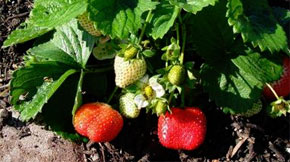Weekend Gardening: Strawberries
October 9, 2010
In many parts of the country, strawberries are a summer crop, but here in Florida they grow best during the cooler months of the year. Plant yours between October 15 and November 15 to enjoy tasty berries in the spring.
 Temperatures between 50 and 80 degrees F and less than 14 hours of daylight are required for the development of flowers and fruit on most strawberry varieties. This combination of day length and temperature exists for much of the fall, winter and spring in Northwest Florida.
Temperatures between 50 and 80 degrees F and less than 14 hours of daylight are required for the development of flowers and fruit on most strawberry varieties. This combination of day length and temperature exists for much of the fall, winter and spring in Northwest Florida.
Strawberry plants are perennial; they can live for several years. However, because of their susceptibility to diseases, we normally grow them as annuals here in Florida. To be successful with strawberries, it’s important to plant the right variety, protect the flowers from freezing weather and manage pests.
The first step in successful strawberry production is choosing adapted varieties. Currently, the University of Florida suggests three varieties for the Florida home garden: ‘Camarosa’, ‘Sweet Charlie’, and ‘Festival’. All three varieties produce attractive, flavorful berries suitable for eating fresh or for freezing.
‘Camarosa’ has been the most productive variety in North Florida. It produces a blocky, dark red berry.
‘Festival’ is the number one variety in Florida. It has good red color and is a firm, conical shape berry with medium sweetness. It is an excellent choice for eating.
‘Sweet Charlie’ is a University of Florida variety. Although it is an older variety, consumers still like it. Its soft sweet fruit is an orange red color.
 Strawberries grow best in a location receiving at least eight hours of direct sunlight per day. If a full sun location is not available, try to choose a spot that is sunny during the morning and early afternoon. The soil should be well drained and slightly acidic with a pH between 5.5 and 6.5.
Strawberries grow best in a location receiving at least eight hours of direct sunlight per day. If a full sun location is not available, try to choose a spot that is sunny during the morning and early afternoon. The soil should be well drained and slightly acidic with a pH between 5.5 and 6.5.
Strawberries can also be planted in growing boxes, strawberry pots, barrels and other containers. For best results, fill your container with a high-quality potting media—do not use garden soil.
Strawberry flowers and fruit can be injured by air temperatures below 32 degrees F. However, if properly planted, the plant itself will not be damaged unless the temperature falls to the low 20’s. If a frost or freeze is predicted, cover the plants with a lightweight blanket. This will help prevent the flowers or fruits from getting damaged.
The key to successful pest management is to begin with healthy, disease-free transplants. If problems do arise, be sure to contact your local Extension Agent for advice and recommendations. Additional advice is available in an online publication located at http://edis.ifas.ufl.edu/hs403.
The first berries should be ready to pick roughly 90 to 110 days after planting. The harvest season usually stretches through May with fruit yield peaking around March.
Pick berries when at least three-fourths of their surface has turned red. The fruit quickly deteriorate once it becomes totally red. So, it is best to harvest regularly—every two to four days.
Once picked, the berries will not sweeten any further. Freshly picked strawberries generally keep for only a few days, so be sure to eat them soon after harvest. If you have a surplus of berries, you may freeze them.
Theresa Friday is the Residential Horticulture Extension Agent for Santa Rosa County.
Comments
One Response to “Weekend Gardening: Strawberries”



Love these tips!! *now wondering where I can buy some strawberry transplants*